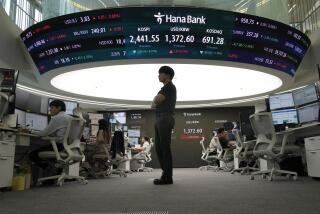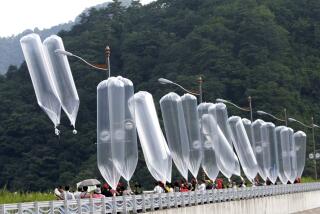S. Korea Gears Up to Challenge U.S., Japan Chip Makers
- Share via
It seems that many Americans learned overnight how to pronounce Hyundai. One day, it was “hi-uhn-dye” and the next, folks were tooling about in odd little cars and rhyming the name with “Sunday.”
In the arcane vocabulary of the semiconductor industry, where most words are easier to say but harder to comprehend, there are more Korean names: Samsung, Daewoo and Lucky-Goldstar.
And a whisper of French. Deja vu .
It wasn’t too long ago that U.S. consumers and manufacturers were learning other foreign names, such as Mitsubishi, Hitachi and Fujitsu. Those were lessons in Japanese that proved costly to the U.S. semiconductor industry.
Now the South Koreans are making semiconductors, too. As their chips find their way into more computers and other electronic goods made by U.S. firms, warnings are being sounded that, like the Japanese before them, the Koreans spell trouble for U.S. chip makers.
The signs are there. The Koreans have a dedicated, low-paid labor force, manufacturing expertise, government incentives and a commitment to being a significant player in the industry. “If you think the Japanese are aggressive and hard-working, you haven’t seen anything. When you look at the Koreans, you see they are very committed to their goals,” said George Haloulakos, a semiconductor industry analyst at Cable Howse & Ragen in Seattle.
The Korean firms have been building the latest, state-of-the-art plants, mostly with equipment from U.S. firms. They are buying or licensing chip technology from U.S. companies and forging development and manufacturing alliances with others. And, the Koreans have had the advantage of watching, closely, the strategies that took the Japanese from zero to 80% of the U.S. market for memory chips in five years.
But, perhaps most importantly for now, the Koreans have the U.S.-Japan trade agreement on semiconductors.
When the Koreans began building up their semiconductor industry in earnest earlier in the decade, most observers said they were poised to enter the market, but needed an opening. They got their break this year when the United States and Japan reached a trade agreement, designed to resolve dumping cases and unfair trade complaints against the Japanese chip makers. The pact imposed higher prices on some Japanese-made chips sold in the United States and, presto, the Korean-made chips became the price leaders.
“The trade pact is giving them (the Koreans) a ceiling they can sell under,” said Andrew Neff, an analyst who tracks semiconductor distributors for Montgomery Securities in San Francisco. “If you know the guys who control 80% of the market can’t sell below a certain point, and you want to sell chips, where are you going to put your prices?”
In 1985, the first year most of the Korean chip makers started selling semiconductors in the United States, they pulled in a mere 0.1% of the total U.S. sales of $9.5 billion. Most industry observers agree that share will be considerably higher this year.
Expects Greater Share
Tom Wang, an analyst with market researcher Dataquest, estimates that the Korean companies will capture 5% of U.S. chip sales this year. Even experts who cite various roadblocks confronting the Korean manufacturers and who predict that their market share will be only 2% to 3% this year concede that the Koreans could become a major factor.
The real debate, many insist, is whether it is the Japanese or the U.S. companies that have the most to fear from the newcomers.
So far, the Korean chip makers have been concentrating their efforts in memory-storage devices such as D-RAMs and Eproms, semiconductors that are made and sold in high volume for use in computers, especially, and other electronic products.
The Japanese companies have excelled in the memory-chip business, combining dazzling manufacturing efficiencies with zealous marketing strategies and cutthroat pricing to take the worldwide lead. Most U.S. companies have turned to making more complex chips and have bowed out of making D-RAMs (dynamic random-access memories); the U.S. position in Eproms (eraseable programmable read-only memories) also is dwindling.
Korean companies, “may go the Japanese one better in making high-volume parts very cheaply. What the Koreans do is manufacturing by rote, once they’re shown how to make one part they begin churning them out by the millions,” said Drew Peck, semiconductor analyst at the Gartner Group in Stamford, Conn. “I actually think the Japanese are in serious trouble. Their cost structure is such now that the Koreans will be eating their lunches in D-RAMs.”
The Japanese chip makers, who have been found in violation of U.S. laws that prohibit dumping--that is, selling below fair market value--have in turn suggested that the Koreans are also dumping chips. Though industry observers say the U.S. government is monitoring the Koreans closely, it is unlikely that action will be taken against the Korean chip makers unless the U.S. industry presses for it.
Korean chip makers say they are not dumping chips in the U.S. market. “This company has been bending over backwards to maintain fair prices vis-a-vis costs,” said a spokeswoman for Samsung’s U.S. operations. “We’re too smart too dump.”
For now, however, the U.S. industry is still most concerned with enforcing the semiconductor trade agreement with Japan. If attempts to end dumping of Japanese chips in Southeast Asia prove successful, the Koreans may benefit. The Koreans sell chips in places such as Taiwan and Singapore, but because of production limitations, sometimes appear to be “phantoms” in the worldwide market. “First you see evidence they’ve been selling, then they’re gone and the next month they’re back,” said one analyst.
Maintaining a permanent presence in the U.S. market is a goal for each of the four Korean companies that have opened up marketing operations here.
Samsung Semiconductor & Telecommunications, a division of the giant Samsung Group, is the leading Korean seller of chips in the United States so far. Although the company does not disclose what portion of its $13.7 billion in sales comes from semiconductors, analysts have estimated its chip sales totaled $95 million worldwide in 1985.
In the last three years, Samsung has spent $600 million on semiconductor manufacturing facilities. Most of that, according to Nancy Gilbert of the firm’s U.S. arm in Silicon Valley, went to building a “state-of-the-art” semiconductor village in South Korea, complete with housing for the workers.
Hyundai, another chaebol , or conglomerate, dove headlong into electronics components in 1983 and so far has spent more than $250 million to build semiconductor manufacturing facilities. Just as it made a splash in the U.S. market this year with its inexpensive cars, followed by personal computer clones that now are rocking the PC market, it is looking to make it big in microchips.
Predicts Jump in Sales
C. S. Park, head of the company’s Hyundai Electronics group in Silicon Valley, said that in six months last year, sales were “only about $2 million, but we are going to try to build that up to $10 million next year.”
Hyundai and Samsung are primarily concentrating on memory devices, and thus pose the most immediate threat to the dominant Japanese. But Daewoo and Lucky-Goldstar may yet expand their chip ventures in that direction as well.
Daewoo abandoned its first foray into the U.S. chip market in late 1985, in the midst of the worldwide semiconductor industry slump. But it returned this year with its $13.4-million purchase of a controlling interest in ZyMOS, a custom-chip company in Silicon Valley.
Lucky-Goldstar teamed up with American Telephone & Telegraph to form its semiconductor division, called Goldstar Semiconductor. It “just barely started selling” its logic devices in the United States this year, but will expand its U.S. operations next year, said Sungho Kang, vice president of the firm’s Sunnyvale, Calif. operations.
In addition to their own products, the Koreans are serving as foundries for American companies, sometimes doing full manufacturing, or in other cases assembly, packaging and testing. Such arrangements will help them fill out their capacity and achieve the kind of full-scale production that industry experts say is necessary to perfect the manufacturing processes.
Although the Koreans have relied heavily on licensing technology and hiring engineers from the U.S. companies, the Japanese also have played a role in getting the Koreans started.
Industry observers tell of how just a couple of years ago, the Saturday night flights from Tokyo to Seoul were choked with Japanese engineers on their way to $1,000-a-day weekend jobs advising the Koreans on building semiconductor manufacturing lines.
Now, said analyst Haloulakos, “The Japanese are very worried about the Koreans.”
“It’s going to be tough for the Japanese,” he said. “They’ve got everything going against them at the same time, their currency (which has risen against the U.S. dollar), the trade agreement and now, changes in the way they do business at home. Because they aren’t selling enough chips in the U.S., they’re going through pricing battles in their own market. And Korea is the wild card.”
But Haloulakos believes that just because the Koreans are making their main forays into the memory-chip market is no reason for U.S. companies to be lulled into complacency.
“There are long-term implications for the U.S.,” he said. “Seeing the Koreans move in could give the Japanese even more incentive to get in the value-added (products), the custom chips and microprocessors areas that the U.S. dominates.”
So far, though, the Japanese have had little success in challenging the U.S. leadership in in the more sophisticated semiconductor products, such as microprocessors (chips that not only store but manipulate information) and complicated chips designed for specific applications (often referred to as ASICs, or application specific integrated circuits).
In the past two years, the U.S. semiconductor industry has responded to the worldwide slump in demand and the encroachment of the Japanese with massive restructuring programs, focusing more of its resources on the sophisticated and custom-design chips, which sell to smaller, but seemingly more secure niches.
Too, U.S. companies have become much more protective of their technology in recent years, refusing to license the most advanced designs, staunchly enforcing licensing agreements and defending patents. Although they continue to undertake joint ventures with Japanese companies, the new posture toward foreign manufacturers is guarded.
“We have done joint development programs, done technology exchanges,” said a spokesman for Advanced Micro Devices, “but we will not sell, for money, current state-of-the-art technology . . . we will exchange technology for technology we feel will be important to us.”
In January, 1985, Intel, another major Silicon Valley semiconductor maker, entered into a agreement to allow Samsung to manufacturer and market several of its microcontrollers, microprocessors and peripheral products. Although the company would not specify which of its products were involved, it is generally believed that they are not the latest generation chips.
Texas Instruments uses Hyundai as a subcontractor on packaging, assembly and test work. The Dallas-based firm had licensed some of its memory-chip technology to Samsung, but those licenses expired, and TI has charged Samsung and several Japanese firms with patent infringement on such products.
Motorola, which recently announced a technology development venture with Japanese chip maker Toshiba, has no Korean partner; National Semiconductor has talked with Korean companies, but hasn’t made any deals.
“At this stage, the Koreans do not represent a major force in the industry,” said George Scalise, senior vice president of Advanced Micro Devices and a prominent figure in the U.S. semiconductor industry’s efforts to win a trade accord.
Not Well Positioned
“They are participating in D-RAMs and have visions of doing something more. But it strikes me that at this stage, they are not well positioned to be a major force for some time. For one thing, they lack an internal market, and another, they lack the design capabilities to bring out important new products.”
It was the giant but closed home market for chips used in consumer electronics that spurred the Japanese conglomerates’ success in their own semiconductor industry. With its smaller, less developed electronics industry, South Korea must look elsewhere for customers.
And Korea, historically at odds with Japan, has even less chance of cracking the robust Japan semiconductor market than U.S. companies have, especially now that the trade agreement calls for greater access to that market for Americans.
Additionally, in the United States, the Koreans will have a tough time establishing nationwide distribution systems.
“You kind of have to watch ‘Dynasty’ to understand the way the rules work in the semiconductor distributor business,” said Montgomery Securities’ Neff, referring to the television show about the imbroglios of an imaginary Denver oil tycoon’s family.
In general, U.S. chip makers don’t want their distributors to carry their competitors’ lines. While a U.S. maker might not mind being on the same shelf with one domestic rival, it might object to others. Also, Neff said, most U.S. companies would object to being carried by a distributor that also sold Japanese products. “And in terms of the Koreans, there are two kinds of distributors: those who carry them and those who don’t,” he said.
The leading U.S. semiconductor distributor, Hamilton-Avnet, set up a separate company, Time Electronics, to handle Japanese products. This past summer, Hamilton-Avnet stirred up a brouhaha in the distributor business when it began acting as a broker for Samsung chips. “If Hamilton-Avnet picks up a line, it’s like giving it the seal of approval,” said analyst Peck.
Few others have taken on Korean products, however. Howard Franklin, head of the electronics distribution group of Bell Industries, a Brentwood-based company, said: “The Koreans have become a good competitor; the Japanese no longer have the quality or price advantage. But the Koreans don’t want to coexist on distribution shelves with the Japanese, and vice-versa.”
In 256K D-RAMs, the current standard memory chip used in great quantities by computer makers, Korean products are selling for $1.80 to $1.90 in the United States. Recently, industry observers report, Micron Technology, a Boise, Idaho, maker of D-RAMs, dropped its price to $1.75 to compete with the Koreans.
By contrast, U.S. Commerce Department-set prices for Japanese imports of the same chip were initially set at $2.50 to $8; in October, those prices were revised downward to range from $2 to $4, and further revisions will be made this month.
Samsung saw some initial benefit from the U.S.-Japan trade accord, and Japanese chip distributors admit to losing business to the Koreans. Among those purchasing Samsung chips was International Business Machines.
George Tarnawsky, senior vice president of Marshall Industries, an El Monte distributor for Hitachi, Toshiba, Fujitsu and NEC, said the Commerce Department-set prices on Japanese products “are killing us . . . they may put us out of business. We have to buy at much higher prices, and that makes us non-competitive with the Koreans.
“Quite often we’ve been forced to walk away from business because we cannot compete with the Koreans,” Tarnawsky added.
Samsung spokeswoman Gilbert said: “There was a brief spurt of business in the summer,” after the agreement was reached. “But we did not get rich quick.”
Many chip makers, distributors and buyers say that a thriving gray market in Japanese imports has sprung up since the accord was signed. Analysts say the street price for Japanese-made 256K D-RAMs has dropped to $1.90, thus blunting much of the advantage of the Korean’s prices.
The Koreans’ limited product offerings have kept them from being considered by many of the large distributors and by the large buyers. The process a chip-user goes through to verify the quality of a new supplier’s products--called qualifying--is costly, and so far, few large chip users have been willing to spend the money to qualify the Koreans’ products.
“The computer and telecommunications companies spend $50,000 to qualify products,” said Mel Phelps, semiconductor analyst for Hambrecht & Quist in San Francisco. “They do about three (companies) per product type, and the Koreans are coming into the game” at a point when most major users have already qualified several suppliers.
“It’s not an easy task, and these companies don’t drop $50,000 bills easily,” Phelps said. “What has spurred purchases of Korean chips so far has been the fact that they couldn’t get any” other chips inexpensively enough.
For others, buying or selling Korean chips is also question of loyalty.
Marshall has been selling Japanese-made semiconductors for 11 years, and “one doesn’t try to make a U-turn in the Lincoln tunnel,” said Tarnawsky. “We run our business long-term. Why should be run stampeded? One product doesn’t make a business.”
Among the U.S. distributors that refuse to carry foreign manufacturers’ lines are Bell Industries and El Segundo-based Wyle Laboratories, the nation’s eighth-largest semiconductor distributor. “We could distribute anyone we wanted to,” said Wyle President Charles Clough. “But we’ve cast a course to support the American producer.”
Many industry executives aren’t convinced that the Koreans yet pose a significant challenge. “I don’t think it’s going to play out as the Japanese issue has played out,” said Scalise of Advanced Micro Devices. “The industry has changed . . . there are more complex designs. And (the foreign producers) can’t copy them like they used to.”
What the Koreans bring to the market, he said, is “low-cost manufacturing capability in commodity products. But there is adequate capacity already and a depressed market, so that opportunity is a rather limited one.”
Other industry observers note that the Korean products have generally lagged current technology by a generation. “Anybody who’s selling 64K D-RAMs,” said one U.S. executive, “is not in leading-edge technology.”
Hyundai’s Park admits that the Koreans are behind. He said his company is among those working on the next generation of memory chips, and “over the long run, we will be closing the gap.”
Analyst Haloulakos says that it’s possible for the Koreans to do just that. “The worst the U.S. industry could do,” he said, “is underestimate their strengths and overestimate the perceived weaknesses.”
Bell Industries’ Franklin agrees. “All three--the Japanese, Koreans, Americans--are mortal enemies to each other,” he said.
More to Read
Inside the business of entertainment
The Wide Shot brings you news, analysis and insights on everything from streaming wars to production — and what it all means for the future.
You may occasionally receive promotional content from the Los Angeles Times.










